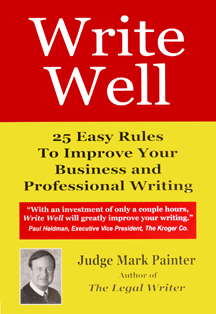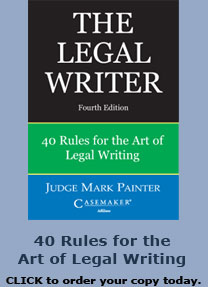Plain language – (literally) halfway around the world
By Judge Mark P. Painter
When the e-mail came from Naseem, asking me to come to Malaysia to talk about plain language, of course I was intrigued. Spreading the word about plain language legal writing has become a passion. And I would be one of three “world-class experts.”
There would be two seminars, one in Kuala Lumpur and one in Penang. The Malaysian government, specifically the Construction Industry Development Board (CIDB), was the sponsor, along with many other groups. Who could resist?
Though I knew where Malaysia is, I hadn’t been in that part of the world. But then, after a bit of Mapquesting, the reality dawned – it is a long way. As the crow flies, it’s 9,500 miles from Cincinnati (Compare: Tokyo 5,700; London 3,950; Moscow 5,050; Baghdad 6,500; Cape Town, 8,300.) The route we (my wife Sue Ann Painter braved the trip) flew was almost 10,500 miles. If you go much farther from Cincinnati, you start coming back. When we returned, we left from the Equator and flew over the polar ice cap – what’s left of it.
A missed day
We left Cincinnati on July 17 and arrived in Kuala Lumpur (everyone calls it KL) on July 19. We missed the 18th – I’m not sure where it went.
Thirty-two hours after our departure, and not as worse for wear as we expected, we arrived at the KL airport, which is new and impressive. We were fetched by a driver holding a name card with my name on it. That’s never happened before.
The KL airport is about an hour ride from town – it was the first place they could find enough flat land. The area around KL is what we would call “rolling,” with some mountains in the near distance.
A vibrant city of about 3,500,000 people, KL is the Malaysian capital.
The seminars
The construction industry is at the forefront of the plain language movement in Malaysia. At first that seemed strange – but who depends on contracts more? And most construction clients, architects, contractors, subcontractors, and managers have trouble with legalese – as does everyone else.
My contact was Sr Noushad Ali Naseem bin Ameer Ali, whom I met through a plain language international listserv. (The Sr is a designation equal to Dr. – it means surveyor – but not in the sense we would understand it. A surveyor is a value surveyor – someone who is a construction industry consultant. Naseem has degrees in architecture and construction management and is working on his PhD.)
Naseem asked four “world class” experts, only one of whom declined – because of the length of the trip. I came the farthest. The two others both came from Sydney, Australia –Peter Butt of the University of Sydney College of Law and Dr. Robert Eagleson, a retired English professor and head of the Victorian Law Reform Commission.
The local presenters were no less accomplished: a retired judge, a practicing lawyer who heads the committee to reform construction contracts, and Naseem, the driving force. (Click here to read the speakers’ bios.)
In KL we had a surprising turnout of more than 350 attendees: lawyers, architects, contractors, subcontractors, administrators, and government officials.
All the presentations were on plain language, with different emphasis. Prof. Butt gave his “myths” of legal drafting: the reasons why some people think “legalese” is better are all myths.
Dr. Eagleson gave examples of documents drafted in legalese, then converted to plain English. As usual, the difference was stunning.
Lawyer Tan Swee Im showed some of the “before” language of the standard construction contract, then the “after.” The committee she heads had been able to cut the number of words by 40%, while gaining, not losing meaning.
Sr. Naseem had a great video presentation on the benefits of plain language in a variety of situations.
At the end of both seminars, the audience was asked whether they wanted to stay with the old legalese or switch to plain language. For the latter, every hand went up.
About six weeks later, I received a thank-you letter from Sariah Abdul Karib, of the CIDB, with this language: “The conference has generated overwhelming support from the audience. … Following the conference, the Design and Build Form Construction Contract is now being redrafted in modern style.”
Now we just need to work on the U.S.
_________________________________
Mark Painter has served as a judge on the Ohio First District Court of Appeals for 13 years, after 13 years on the Hamilton County Municipal Court. Judge Painter is the author of 370 nationally published decisions, 120 legal articles, and 6 books, including The Legal Writer: 40 Rules for the Art of Legal Writing, which is available at http://books.lawyersweekly.com. Judge Painter has given dozens of seminars on legal writing. Contact him through his website, www.judgepainter.org








